Marrying Vega and Zen: The AMD Ryzen 5 2400G Review
by Ian Cutress on February 12, 2018 9:00 AM ESTBenchmarking Performance: CPU Encoding Tests
One of the interesting elements on modern processors is encoding performance. This includes encryption/decryption, as well as video transcoding from one video format to another. In the encrypt/decrypt scenario, this remains pertinent to on-the-fly encryption of sensitive data - a process by which more modern devices are leaning to for software security. Video transcoding as a tool to adjust the quality, file size and resolution of a video file has boomed in recent years, such as providing the optimum video for devices before consumption, or for game streamers who are wanting to upload the output from their video camera in real-time. As we move into live 3D video, this task will only get more strenuous, and it turns out that the performance of certain algorithms is a function of the input/output of the content.
All of our benchmark results can also be found in our benchmark engine, Bench.
7-Zip 9.2: link
One of the freeware compression tools that offers good scaling performance between processors is 7-Zip. It runs under an open-source licence, is fast, and easy to use tool for power users. We run the benchmark mode via the command line for four loops and take the output score.
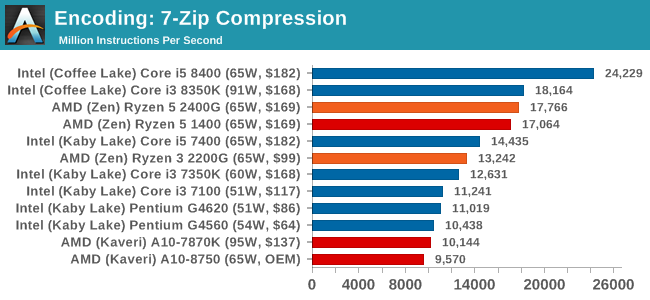
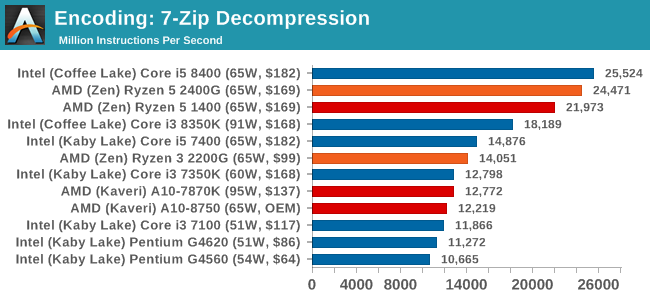
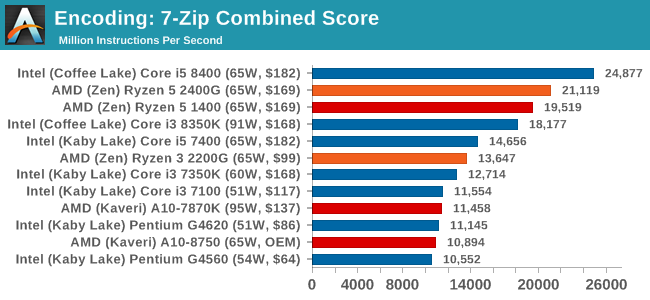
7-zip gives two contrasting stories here. For compression, full cores are needed to get the best performance, with frequency helping as well. However, for decompression, the extra threads help a lot. The combined result looks more like the decompression score, with the Ryzen 5 2400G sitting between the six-core Core i5-8400 and the quad-core Core i3-8350K.
WinRAR 5.40: link
For the 2017 test suite, we move to the latest version of WinRAR in our compression test. WinRAR in some quarters is more user friendly that 7-Zip, hence its inclusion. Rather than use a benchmark mode as we did with 7-Zip, here we take a set of files representative of a generic stack (33 video files in 1.37 GB, 2834 smaller website files in 370 folders in 150 MB) of compressible and incompressible formats. The results shown are the time taken to encode the file. Due to DRAM caching, we run the test 10 times and take the average of the last five runs when the benchmark is in a steady state.
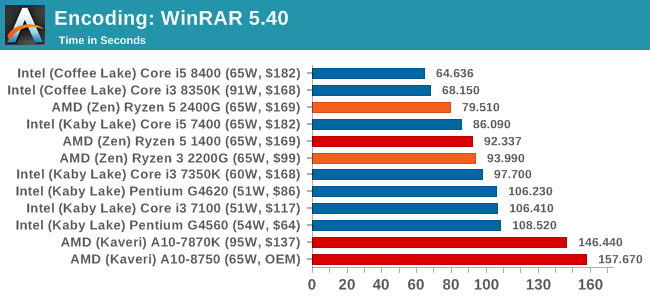
WinRAR is a good scaler with cores, frequency, and memory performance. The eight threads and DDR4-2933 contributes a good amount to the performance here, especially in light of where AMD was. The jump from the Ryzen 5 1400 to the 2400G is also noticable, due to the uptick in frequency and memory speed. The high single-thread performance of the Intel cores still wins out, however.
AES Encoding
Algorithms using AES coding have spread far and wide as a ubiquitous tool for encryption. Again, this is another CPU limited test, and modern CPUs have special AES pathways to accelerate their performance. We often see scaling in both frequency and cores with this benchmark. We use the latest version of TrueCrypt and run its benchmark mode over 1GB of in-DRAM data. Results shown are the GB/s average of encryption and decryption.
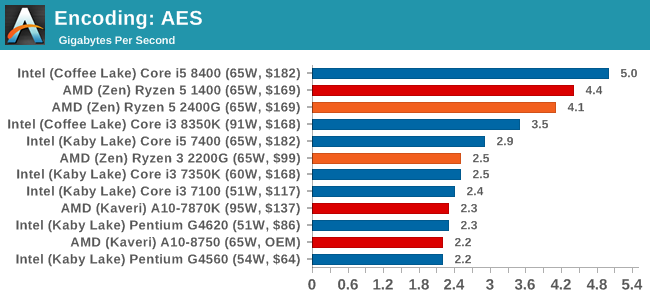
HandBrake v1.0.2 H264 and HEVC: link
As mentioned above, video transcoding (both encode and decode) is a hot topic in performance metrics as more and more content is being created. First consideration is the standard in which the video is encoded, which can be lossless or lossy, trade performance for file-size, trade quality for file-size, or all of the above can increase encoding rates to help accelerate decoding rates. Alongside Google's favorite codec, VP9, there are two others that are taking hold: H264, the older codec, is practically everywhere and is designed to be optimized for 1080p video, and HEVC (or H265) that is aimed to provide the same quality as H264 but at a lower file-size (or better quality for the same size). HEVC is important as 4K is streamed over the air, meaning less bits need to be transferred for the same quality content.
Handbrake is a favored tool for transcoding, and so our test regime takes care of three areas.
Low Quality/Resolution H264: Here we transcode a 640x266 H264 rip of a 2 hour film, and change the encoding from Main profile to High profile, using the very-fast preset.
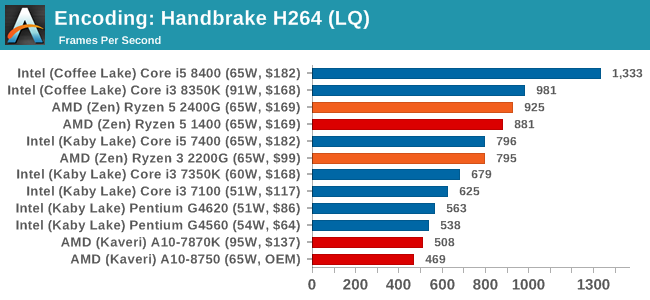
High Quality/Resolution H264: A similar test, but this time we take a ten-minute double 4K (3840x4320) file running at 60 Hz and transcode from Main to High, using the very-fast preset.
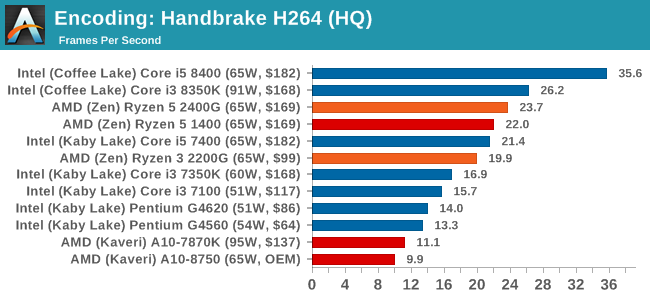
HEVC Test: Using the same video in HQ, we change the resolution and codec of the original video from 4K60 in H264 into 4K60 HEVC.
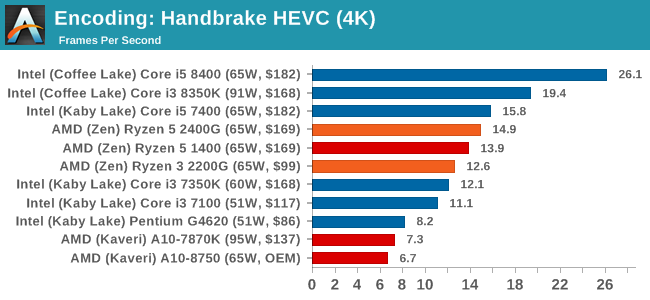










177 Comments
View All Comments
Lolimaster - Monday, February 12, 2018 - link
I would get the Asus X370 pro and the G.Skill Flare X 3200 CL14 (ram is expensive no matter how "cheap" you wanna go)coolhardware - Monday, February 12, 2018 - link
Thank you for the recommendation!!! :-)kaidenshi - Tuesday, February 13, 2018 - link
I'm using the ASRock AB350M Pro4 with a Ryzen 3 1300X, 16GB Crucial Ballistix 2400MHz DDR4 memory, and a GTX 1060 SC. It's been a rock solid board so far, and it has two PCI-E storage slots (one is NVMe, the other is SATA) so you can use it comfortably in a case with limited storage options.I was nervous about it after I read some reviews on Newegg talking about stability issues, but it turned out pretty much all of those people were trying to overclock it far beyond its rated capabilities. It's perfectly stable if you don't try to burn it up on purpose.
Samus - Monday, February 12, 2018 - link
Seriously. It's now obvious why Intel is using AMD graphics. Considering that its mostly on par (sometimes faster, sometimes slower) with a GT 1030, a $100 GPU that uses 30 watts alone, Intel made the right choice using VEGA.Flunk - Monday, February 12, 2018 - link
Wow, that's some impressive numbers for the price point (either of them). I think the R5 2400G would cover the vast majority of users' CPU and GPU needs to the point where they wouldn't notice a difference from anything more expensive. Anyone short of a power user or hardcore gamer could buy one of these and feel like they'd bought a real high-end system, with a $169.99 CPU. That's real value. I kinda want one to play around with, I don't know how I'll justify that to myself... Maybe I'll give it to my father next Christmas.jjj - Monday, February 12, 2018 - link
Was hoping to see GPU OC perf and power, won't scale great unless the memory controller can take faster sticks (than Summit Ridge) but we still need to figure it all out.iter - Monday, February 12, 2018 - link
Most other sites' reviews feature overclocking and power.Ian Cutress - Monday, February 12, 2018 - link
I started an initial run with higher speed memory, but nothing substantial enough to put in the article just yet. I'm planning some follow ups.jjj - Monday, February 12, 2018 - link
Looking forward to all of that.Anyway, they do deliver here for folks that can't afford discrete or got other reasons to go with integrated. Even the 2400G is ok if one needs 8 threads.
Kamgusta - Monday, February 12, 2018 - link
Where is the i5-8400 that has the same price as the 2400G?Oh, yeah, they totally left it out from the benchmarks since it would have proved an absolute supremacy of the Intel offering.
Ops.